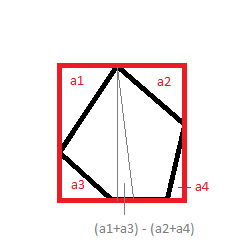This is a reply to the answer by helps_7766,
and it should be posted as a comment, but it's too long, so I decided to post it as an answer.
Unfortunately, the method presented does not 'yield the center of mass of the pentagon'. As a counterexample let's see the image:

The center of mass of the black triangle (on the left) is at $1/3$ of its height.
If we add two narrow red triangles along the black triangle's sides, with their 'free' vertices close to the central triangle's base (in the centre), then their centers of mass lie close to the $1/3$ of the new figure's heigth, too. Thanks to the symmetry, the triangle defined by the three centers (blue dots) will have its resulting center (marked with a blue diamond) somewhere close to the center of mass of the black triangle.
However, if we shift the fourth and fifth vertex close to the apex (image to the right), the centers of mass of red triangles will also move up – up to $2/3$ of the figure's height. Then the resulting triangle defined with blue dots will have the center of mass (blue diamond) at approx. $\left(\frac 13 + \frac 23 + \frac 23\right)/3 = 5/9$ of the figure's height.
Please note that we can make the red triangles as thin as we want, effectively obtaining a spatial distribution of the mass of our pentagon indistinguishable from the black triangle. Anyway, the resulting point will appear at positions described above.
That's because the three blue points' heights depend linearly on the heights of vertices of respective triangles, but they do not depend on the triangles' areas. Hence they can be shifted significantly with appropriate vertex shifts with no significant change in the area.
As a result, the supposed 'center of mass' has little to do with actual mass distribution and with an actual center of mass.
Not to mention a line through the center of mass does not half the area, usually. For example a 'horizontal' line through the triangle's center of mass divides its area as $\frac 49$ (the top triangular part) to $\frac 59$ (the bottom trapezoid part). If you want to half a triangle with a line parallel to the base, you should draw it at $1-\frac 1{\sqrt 2}\approx 0,293$ of the triangle's height, that is approx. $\frac 1{25}$ of the triangle's height below the center of mass!







